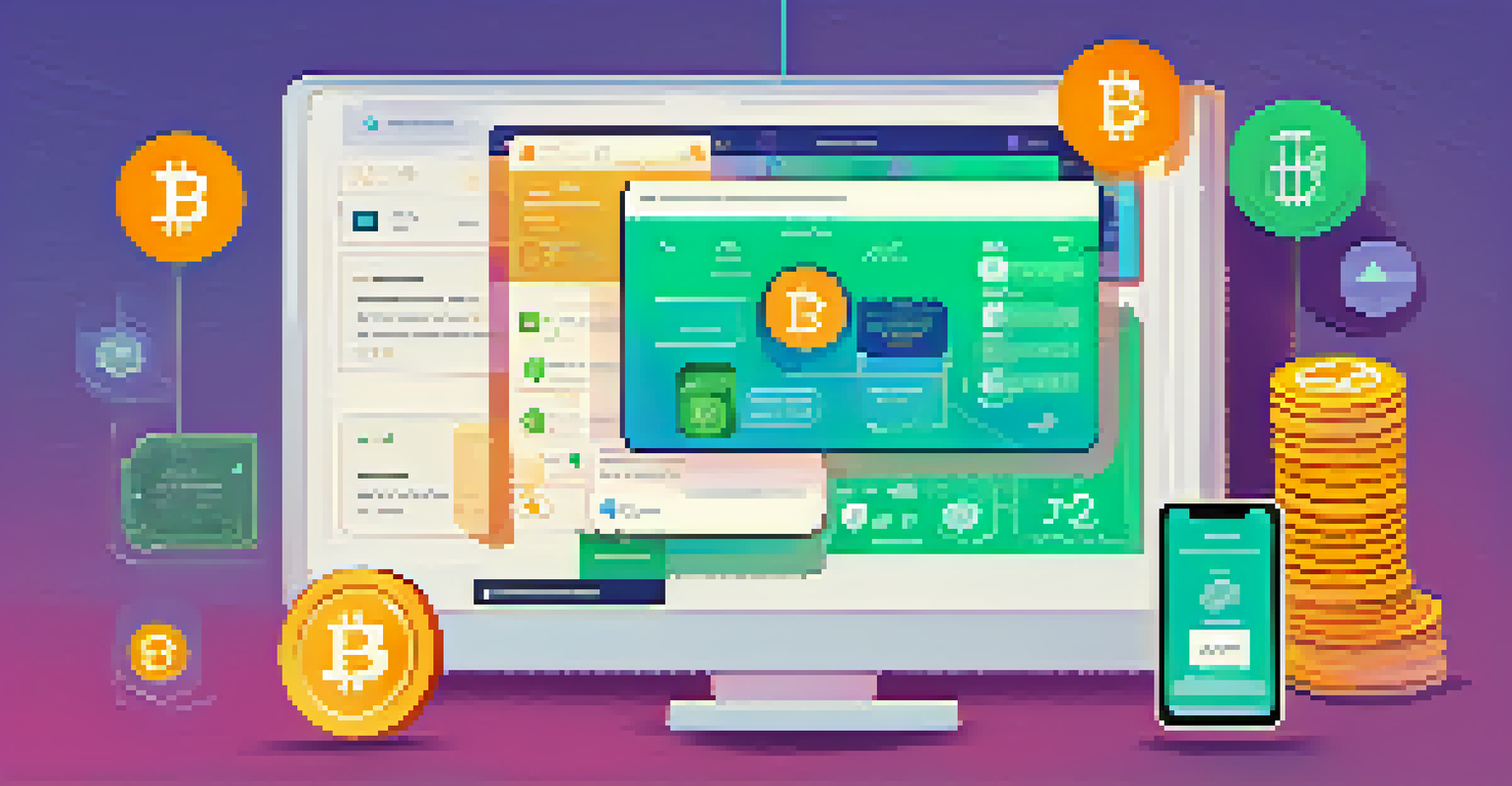The Future of Cross-Chain Bridges in Decentralized Finance

Understanding Cross-Chain Bridges in DeFi
Cross-chain bridges are vital components in the decentralized finance (DeFi) ecosystem, enabling the transfer of assets across different blockchain networks. Think of them as highways that connect various cities (blockchains), allowing traffic (assets) to flow smoothly between them. Without these bridges, users would be stuck on isolated chains, limiting their ability to utilize diverse DeFi services.
Interoperability is the key to the future of decentralized finance, allowing different blockchain networks to communicate and collaborate effectively.
These bridges work by locking assets on one chain and minting equivalent tokens on another, creating a seamless experience for users. For instance, if you want to use Ethereum-based DeFi applications but hold Bitcoin, a cross-chain bridge can help you convert your Bitcoin into a wrapped version on Ethereum. This functionality enhances liquidity and promotes a more integrated DeFi landscape.
As DeFi continues to grow, the importance of cross-chain bridges will only increase. They not only facilitate asset movement but also encourage innovation and collaboration between different blockchain ecosystems. This interconnectedness is essential for the long-term success of decentralized finance.
Current Challenges Facing Cross-Chain Bridges
Despite their potential, cross-chain bridges face several challenges that hinder their widespread adoption. Security is a primary concern; vulnerabilities in bridge protocols can lead to significant hacks and loss of funds. For example, if a hacker exploits a flaw in a bridge's code, they could drain assets locked on that bridge, creating distrust among users.

Another issue is the complexity of using these bridges. For many users, the process can feel cumbersome, requiring multiple steps and a level of technical knowledge that not everyone possesses. This can deter newcomers to the DeFi space, limiting the growth of cross-chain bridges.
Cross-Chain Bridges Enhance DeFi
Cross-chain bridges facilitate the seamless transfer of assets across different blockchain networks, promoting liquidity and user engagement in decentralized finance.
Additionally, regulatory uncertainties pose a challenge. As governments begin to scrutinize the cryptocurrency space more closely, cross-chain bridges may face regulatory hurdles that could impact their operation. Navigating this evolving landscape will be crucial for the future of cross-chain technology.
Innovations Driving Cross-Chain Bridge Development
The future of cross-chain bridges looks promising, thanks to ongoing innovations in blockchain technology. Projects are actively working on creating more secure and user-friendly bridge solutions. For instance, some bridges are implementing more robust verification methods to enhance security against hacks, ensuring that user funds are safe.
Cross-chain bridges are not just about technology; they represent the evolution of financial systems towards a more inclusive and accessible model.
Moreover, the integration of layer-2 solutions is helping to improve the efficiency of cross-chain transactions. These solutions can significantly reduce transaction fees and processing times, making cross-chain operations more appealing to users. Imagine being able to transfer assets instantly and affordably, which would redefine user experience in DeFi.
Finally, community-driven approaches are emerging, where users can participate in governance and decision-making processes regarding bridge protocols. This inclusivity fosters innovation and ensures that bridges evolve in a way that meets the needs of their users, paving the way for a more resilient DeFi ecosystem.
The Role of Interoperability in DeFi
Interoperability is a crucial element in the success of cross-chain bridges. It refers to the ability of different blockchain networks to communicate and interact with each other seamlessly. Just like how different apps on your smartphone can work together, interoperability allows various DeFi platforms to share data and assets, enhancing the user experience.
With improved interoperability, users can access a wider range of financial products across different chains without worrying about compatibility issues. This means you could easily trade assets or provide liquidity on multiple platforms without jumping through hoops. Such fluidity will encourage more users to engage in DeFi, ultimately driving growth across the ecosystem.
Challenges Hinder Adoption
Security vulnerabilities, complexity, and regulatory uncertainties pose significant challenges that hinder the widespread adoption of cross-chain bridges.
As developers focus on creating interoperable solutions, we can expect a more cohesive DeFi landscape. This will not only benefit existing users but also attract newcomers looking for diverse investment opportunities. The synergy created through interoperability can lead to innovative financial products that leverage the strengths of multiple blockchains.
User Experience and Cross-Chain Bridges
Enhancing user experience is paramount for the adoption of cross-chain bridges in DeFi. Many current solutions can be intimidating for newcomers due to their technical nature and complicated user interfaces. By simplifying these processes and making them more intuitive, developers can invite a broader audience into the DeFi realm.
For example, imagine a user-friendly interface that guides you through each step of bridging assets, complete with visual aids and clear instructions. This kind of approach can demystify the bridging process and encourage more users to explore cross-chain options. A positive user experience fosters trust and confidence in the technology.
Additionally, educational resources play a vital role in improving user experience. Providing tutorials, FAQs, and community support can empower users to confidently navigate the world of cross-chain bridges. The more informed users are, the more likely they are to engage with and utilize these essential DeFi tools.
Future Trends in Cross-Chain Bridges
Looking ahead, we can identify several trends that may shape the future of cross-chain bridges in DeFi. One significant trend is the rise of automated and decentralized bridges that minimize the need for intermediaries. By removing these middlemen, transactions can become faster and cheaper, aligning with the core principles of decentralization.
Another trend is the increasing focus on cross-chain liquidity pools. These pools allow users to provide liquidity across multiple chains simultaneously, maximizing their earning potential. This approach not only boosts liquidity but also encourages users to engage with various DeFi platforms, driving further adoption.
Future Trends Promote Innovation
Emerging trends such as automated bridges, cross-chain liquidity pools, and increased collaboration between blockchain projects are set to drive innovation and efficiency in the DeFi landscape.
Lastly, we can expect to see greater collaboration between different blockchain projects. As the DeFi space matures, partnerships aimed at enhancing cross-chain capabilities will likely emerge. These collaborations can lead to more robust and efficient bridge solutions, ultimately benefiting the entire ecosystem.
Conclusion: The Promise of Cross-Chain Bridges
In conclusion, cross-chain bridges hold immense promise for the future of decentralized finance. They are crucial for enabling asset movement between disparate blockchain ecosystems, fostering innovation, and enhancing user experience. As we continue to address the challenges facing these bridges, their potential to revolutionize the DeFi landscape becomes clearer.
The ongoing advancements in technology, coupled with a focus on user-centric design, will pave the way for more secure and efficient cross-chain solutions. With interoperability at the forefront, we can expect a more connected and vibrant DeFi environment that encourages participation from a diverse user base.

As the future unfolds, embracing the possibilities of cross-chain bridges will be key to driving the next wave of growth in decentralized finance. By harnessing their power, we can build a more accessible, inclusive, and innovative financial system that benefits everyone.